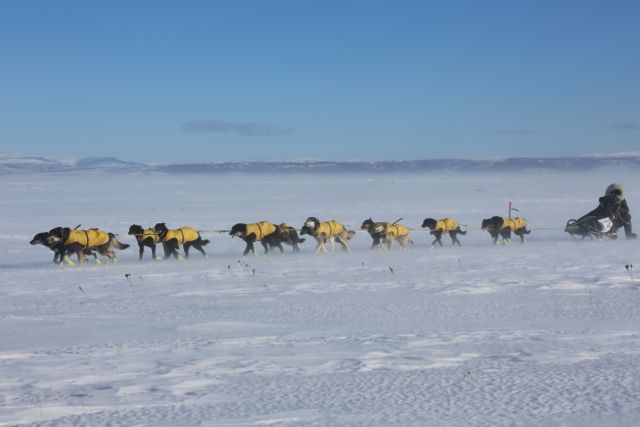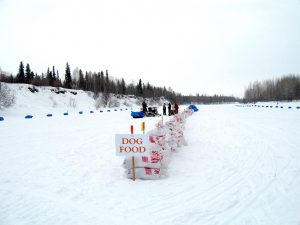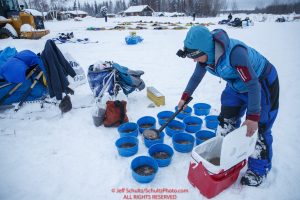
Brent Sass on the Iditarod Trail. Photo Credit: Iditarod
We’re off to a great start with our “All Sass September,” so let’s look at one of the factors that contributed to Brent Sass winning the 2022 Iditarod – physical fitness. As Sass states, “The physical ability of the musher has become a much larger factor in the race over the last 10 years.” Many of my students see the musher as a passenger, just cruising along on the sled while the dogs do all the work. That couldn’t be farther from the truth. Running the Iditarod is a grueling endeavor and the mushers are working hard alongside their dog team. Mushers need to be in top physical shape, just like any elite athlete. So how do they do it? I’ll let Sass sum it up, “My life keeps me in shape”.

It takes an enormous amount of work to run a kennel. This spring I saw this firsthand when IditarodEDU Teachers visited 17th Dog Kennel, Home of Iditarod veteran Matt Failor. Photo Credit: Iditarod
The life of a dogsled musher, especially one who lives on a remote homestead and raises huskies as Sass does, revolves around tasks and responsibilities crucial to daily survival. What that means, according to Sass is, “I don’t have an office that I sit in for eight hours a day, I’m constantly moving around. Cutting firewood was a really big one last year. I cut like 10 cords of firewood and that’s what’s heating our buildings and what’s keeping us warm throughout the season. So that’s clearly a very functional task that we have to do.” Training to be in peak physical shape isn’t about taking a cardio class or lifting weights – it is about doing the daily movement activities that are necessary to guarantee Sass and his dogs can live safely and comfortably.

Food bags awaiting mushers at an Iditarod Checkpoint. That is a lot of heavy lifting to get all the dogs fed! Photo credit: Terrie Hanke
I mentioned lifting weights. Don’t get me wrong, Brent does plenty of lifting – just not in a gym. “I carry five gallon buckets of water and dog food around all day long, and we’re staying in shape just because we are carrying buckets of poop around. It’s a very physical activity. I’m lifting, you know, carrying dogs and we’re carrying large sheets of plywood [for dog houses]. You don’t have to lift weights, you just got to keep moving.”
One of the grueling physical aspects of Iditarod is the length of time mushers spend on the back of the sled. For Sass his daily life is training for those long hours. “I’m on my feet 16 to 20 hours a day sometimes. When you’re on your feet that long you just stay in shape.” The 2021-2022 season was especially grueling as Sass spent much of the training season alone, which was actually a benefit. “I was here alone for a good portion of the season. I stayed in shape because I had to do everything. My physical shape just went through the roof, which was a huge part of the race success this year.”
Take a page from Brent Sass’ book (library pun intended) and introduce your students to the benefits of functional fitness tasks. This can be especially powerful for the “less athletically inclined students” who are used to seeing fitness as excelling in a sport.
Click HERE for a full lesson plan for Physical Education Stations that mimics some of the movements necessary to be a dogsled musher.

Anja Radano portions her dogs’ food into bowls in the morning at the Nikolai checkpoint during the 2018 Iditarod race. That is a lot of food and a lot of math!
Photo by Jeff Schultz/SchultzPhoto.com (C) 2018 ALL RIGHTS RESERVED
This lesson can be extended by classroom teachers to integrate movement into math lessons! Carry those buckets of water, scoop that poop, and lug the bags of food; then multiply that by 55 dogs to get a sense of how much is carried in a day. Learning about time? Use a stopwatch to time each student carrying a bucket for a measured distance. How long would it take to do that 55 times? How many food/water dishes can one bucket fill? – Add measurement into the mix!
Clearly Brent Sass knows the value of functional fitness (staying in shape doing everyday tasks that keep his home and kennel running smoothly). But really, how is it FUN? Brent Sass explains, “Whether I’m cutting brush for 8 hours a day or standing on the back of a dog sled for 20 hours a day or running around with puppies, you know, I find joy in everything that I’m doing. If you find that thing that makes you happy, the hard stuff is even easy. The hard stuff is even fun. The shoveling poop becomes a really fun thing to do because everything around it is worth it. All the hard work is worth it when you find something that’s your passion.” So yes, lifting, pulling, shoveling, and running is hard work – but functioning effectively to do these tasks enables Brent Sass to do something he loves – running dogs. Being healthy and strong has an impact on reaching student goals, and moving everyday can get your students closer to success.

Brent Sass giving his dogs the assist with a left leg pedal. Photo Credit: Iditarod
Library Learnings: The Couch Potato by Jory John is a great story to help students learn about the benefits of getting away from screens and moving their bodies – especially in the great outdoors! Brent Sass and I connected via zoom for this interview, but it didn’t go perfectly. We each froze a few times, and had some minor sound issues. And we had to set up a specific time to meet because Sass definitely isn’t tied to a screen: heading out to take care of the kennel is top priority! Making outdoor time a priority is key for student health and wellness, too!


